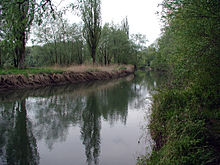Alpine Rhine
The Alpine Rhine Valley (
From Reichenau, the Alpine Rhine flows east, passing

The Rhine Valley's upper third has the character of an Alpine valley, enclosing a bottom plain of about 1 to 4 kilometres (0.6 to 2.5 mi) across. Downstream of Vaduz, the valley widens considerably, developing into a broad plain, measuring some 10 kilometres (6.2 mi) across at its lower end along the southeastern shores of Lake Constance. From the point of the Rhine's emergence from Lake Constance, it is known as High Rhine.
Right tributaries of the Alpine Rhine are the

Geography

The Alpine Rhine Valley is flanked by the Alps and its mountain ranges (especially Alpstein, Plessuralpen, Rätikon Calanda, the Albula Alps and the Glarner Alps), some higher than 3,000 m (9,800 ft). The highest mountain, Ringelspitz, commences next to Tamins. At 3,247 m (10,653 ft), it is the highest peak of the canton of St. Gallen, bordering the valley to its southeast.
Subdivisions
Geographical parts of the Alpine Rhine Valley are:
Upper half:
- (SG).
Lower half:
- To the north, the Bündner Rheintal crosses into the Rhine valley between Sargans and Lake of Constance, where it largely forms the border between the canton of St. Gallen on the west side and Liechtenstein and Austria on its east side. The valley is simply called the Rhine Valley on either side. The Swiss sometimes also call it the St. Gall Rhine Valley in order to distinguish it from its upper half.
- St. Gall Rhine Valley (German: St. Galler Rheintal): On its western side, the Rhine Valley is politically further divided into Werdenberg (Wahlkreis) and Rheintal (Wahlkreis), though geographically it is separated by the Hirschensprung near Rüthi (SG).
- Eastern side:
- On its eastern side, the upper half of the valley is called the Liechtenstein Rhine Valley (German: Liechtensteiner Rheintal).
- Voralberg. It is further divided into an upper and lower part and referred to as the Upper and Lower Lands (German: Vorarlberger Unter- und Oberland). The Lower Lands, sometimes also called Vorderland, stretches from the shores of Lake Constance to the small hill Kummaberg to the south, the upper part lies south of it.
The Rhine

The Alpine Rhine begins in the centre of the Swiss canton of Grisons, and later forms the border between Switzerland to the west and Liechtenstein and later Austria to the east.
It is formed near Tamins-Reichenau by the confluence of the Anterior Rhine and the Posterior Rhine. It descends from an elevation of 585 to 396 metres (1,919 to 1,299 ft).
The river makes a distinctive turn to the north near
Near Sargans a natural dam, only a few metres high, prevents it from flowing further to the north-west into the open valley, called
| Designations | |
|---|---|
| Official name | Rheindelta |
| Designated | 16 December 1982 |
| Reference no. | 275[3] |
The mouth of the Rhine into Lake Constance forms an
A regulation of the Rhine was called for, with an upper canal near
The cut-off Old Rhine at first formed a
Culture

The Alpine Rhine Valley is characterised by a very active culture scene. The Bregenzer Festspiele as well as the Kunstmuseum Liechtenstein have great significance and popularity beyond the region. From a regional perspective, there are many platforms, events and projects that enhance the cultural life of the inhabitants and the local actors.[4] In Widnau, the only international artistic gymnastics tournament for male juniors and seniors in Switzerland takes place. It's named Rheintalcup after the Alpine Rhine Valley.
An example of cross-border cooperation in the Alpine Rhine Valley is the cultural axis of the cities Bregenz, St.Gallen, Vaduz and Chur: The Kunsthaus Bregenz, the Kunstmuseum St. Gallen, the Kunstmuseum Liechtenstein and the Bündner Kunstmuseum in Chur have been cooperating since 2001. Visible signs of this cooperation of the four institutions from three countries are the joint presentations on the "ART BODENSEE" each year.[5]
History
Middle Ages
The valley was part of the ancient
Rule of the Rhine Valley was fragmented throughout the Middle Ages, with the
Vogtei Rheintal
By 1424, the Rhine Valley was largely in the hands of the
Early modern history
Swiss Reformation
In 1528, the
Liechtenstein
The
Napoleonic era
As a result of the
In 1798, the Vogtei Rheintal
With Napoleon's
Modern history
The Bezirk was split in twain in 1831, creating Oberrheintal, with its capital in Altstätten, and Unterrheintal, with its capital alternating between Rheineck and Berneck, St. Gallen. This division persisted until 2003, when a constitutional revision created the modern constituency (Wahlkreis), with the loss of Thal to the adjacent Wahlkreis of Rorschach.
Gallery

See also
References
This article includes a list of general references, but it lacks sufficient corresponding inline citations. (December 2015) |
- ^ Alpenrhein, Zukunft Alpenrhein - IRKA Internationale Regierungskommission. "Der Rhein und sein Einzugsgebiet". www.alpenrhein.net (in German). Retrieved 2017-04-03.
- ^ Bodensee, IGKB - Internationale Gewässerschutzkommission für den. "Aufgaben und Ziele - IGKB - Internationale Gewässerschutzkommission". www.igkb.org (in German). Archived from the original on 2017-04-04. Retrieved 2017-04-03.
- ^ a b "Rheindelta". Ramsar Sites Information Service. Retrieved 25 April 2018.
- ^ "Aspects of sustainable regional development in the border area of the Alpine region, Page 42" (PDF).
- ^ "Pressearchiv der ART BODENSEE". artbodensee.messedornbirn.at. Retrieved 2020-03-21.
- Lorenz Hollenstein: Rheintal in German, French and Italian in the online Historical Dictionary of Switzerland.
